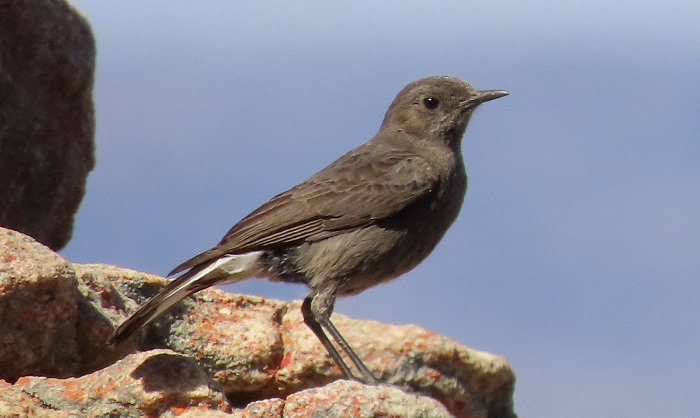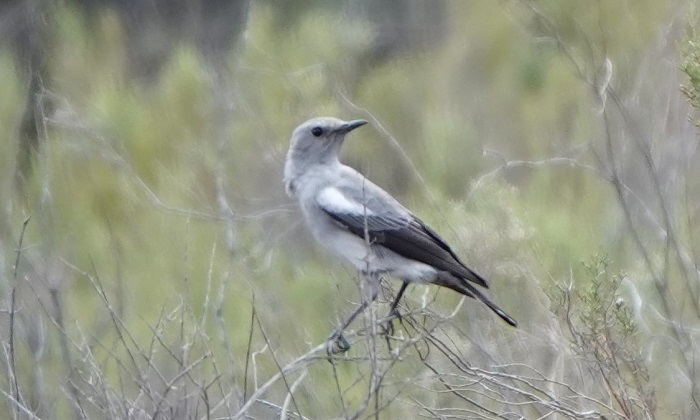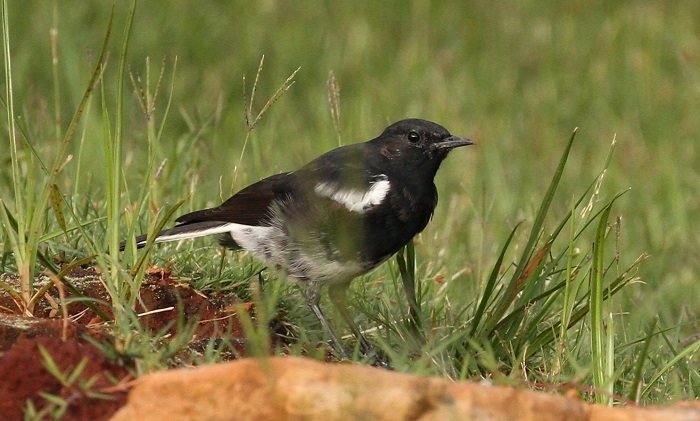Cover image of Mountain Wheatear by Gerald Wingate – Britannica Bay, Western Cape – BirdPix No. 213648
Identification
Mountain Wheatears are handsome and conspicuous birds. They are polymorphic, meaning that the males are found in two differing colour forms. Males can be either grey or black and either with or without white shoulder patches and grey or white crowns. Black form males are slightly more common, accounting for some 54% of the population while grey birds make up the remaining 46% of males.

Rooiklip Farm, Namibia
Photo by Johan and Estelle van Rooyen
Black morph: The overall colouration is jet black. The crown, forehead and nape can be white, black, dark ash-grey or pale grey. The upper tail coverts and rump are white and the tail is black with white outer feathers (diagnostic). The shoulder patch may be absent or strikingly white. The belly is most often black but can be white or mottled white and grey. The flight feathers are dark brownish-black. The bill, legs and feet are black and the eyes are dark brown.
Grey morph: The entire body and underwings are ash-grey. The upper tail coverts and rump are white and the tail is black with white outer tail feathers (diagnostic). The white shoulder patch is variable in size and in some males may be absent all together. The crown is normally ash-grey but can sometimes be white. Underparts are pale ash-grey and the belly too can occasionally be pure white. The under tail may be black, white or grey. The flight feathers are dark brownish-black. The bill, legs and feet are black and the eyes are dark brown.

Bushmanskloof, Western Cape
Photo by Zenobia Van Dyk
Females and juveniles are more uniform in their appearance and are entirely sooty brownish-black but share the black and white rump and tail pattern of the males.

Bushmanskloof, Western Cape
Photo by Zenobia Van Dyk
Similar species: Black males are most easily mistaken for Arnot’s Chat (Myrmecocichla arnoti) but that species has an all black rump and tail. Additionally, the ranges of the two species are not known to overlap and they both occupy very different habitats.
Confusion is perhaps most likely between female/juvenile Mountain Wheatears and the Ant-eating Chat (Myrmecocichla formicivora). Both species co-occur over a wide area but they have different habitat preferences. The Ant-eating Chat is smaller and shorter-tailed with a dark rump and tail and conspicuous white panels in the wings.
The Karoo Chat (Emarginata schlegelii) may also be mistaken for the grey morph Mountain Wheatear but the Karoo Chat is smaller and has a grey not white rump.
Status and Distribution
The Mountain Wheatear is a common resident but may move locally in response to food availability in arid areas. It is near-endemic to Southern Africa and extends from south-western Angola along the western and central parts of Namibia into South Africa where it is widespread across the interior. The Mountain Wheatear is essentially absent from the Kalahari and the Lowveld, as well as the eastern and southern coastlines in South Africa.
Major historical changes in distribution are unlikely. Its preferred habitat remains relatively secure and the species is under no immediate threat.
In the Transkei region of the Eastern Cape, the Mountain Wheatear appears to have benefitted from acute overgrazing. This has led to the formation of deep and extensive erosion gullies providing suitable habitat for this species.

Details for map interpretation can be found here.
Habitat
Inhabits rugged mountain slopes, rocky hills and outcrops, valley slopes, erosion gullies, quarries and also boulder-strewn flat terrain. Vegetation in its habitat ranges from arid Karoo scrub to grassland. Generally avoids woodland. Mountain Wheatears will utilise human habitations such as houses and farmyards where these occur close to suitable habitat.

Photo by Ryan Tippett
Behaviour

Graafwater, Western Cape
Photo by Gerald Wingate
Mountain Wheatears are usually found singly, in pairs or small family groups. Flies low from perch to perch and moves restlessly over rocks with long hops. Usually perches conspicuously on boulders, rocks, termite mounds, trees or buildings. Becomes tame, yet remains wary in and around human settlements.
Forages on the ground and on rocks and captures prey by pecking items from the substrate or after a short dash. Also drops onto prey from a perch or hawks insects in flight, frequently returning to the same perch. Eats mainly invertebrates such as spiders, solifuges, millipedes, centipedes, grasshoppers, termites, ants, flies, bugs and beetles. They They are also known to consume some small fruits and seeds.

Spitzkoppe Nature Reserve, Namibia
Photo by Johan and Estelle van Rooyen
Mountain Wheatears are monogamous birds that nest solitarily. They are also territorial and defend the nest area against conspecifics, other chats, Fiscal Flycatcher (Melaenornis silens) and the Southern Fiscal (Lanius collaris).
The nest is a neat, shallow cup lined with hair, wool or the plumes of fluffy seeds. The nest is built on a messy foundation of debris that can include twigs, grass, trapdoor spider nest entrances and other spider webs, assorted insect larval and pupal cases, bark, dried moss, bits of dung, snake skins and small stones etc. A nest site is selected under a hillside boulder, a cavity in a rock, wall or building, or almost any suitable space around farmyards or abandoned buildings. Nests are built entirely by the female. Successful nest sites are frequently used in successive years and breeding is opportunistic after rain in arid areas.
2-4 (usually 3) eggs are laid per clutch and all incubation is performed by the female only. The female will leave the nest at times to forage and the males presence near the nest increases as incubation progresses. He is most attentive just before hatching, when he becomes very protective, chasing conspecifics and any other black-and-white bird species.
Newly hatched young are fed a diet of insects and their larvae, by both parents. Mountain Wheatears often raise two or three broods per season and some broods are parasitised by Diderick Cuckoo (Chrysococcyx caprius).

Near Matjiesfontein, Western Cape
Photo by Itxaso Quintana
Further Resources
Species text adapted from the first Southern African Bird Atlas Project (SABAP1), 1997.
The use of photographs by Itxaso Quintana, Johan and Estelle van Rooyen, Gerald Wingate, Pieter La Grange and Zenobia van Dyk is acknowledged.
Virtual Museum (BirdPix > Search VM > By Scientific or Common Name).
Other common names: Mountain Chat (Alt. English); Bergwagter (Afrikaans); Khaloli (South Sotho); Traquet montagnard (French); Bergschmätzer (German); Bergtapuit (Dutch); Chasco-montês (Portuguese)
Recommended citation format: Tippett RM 2023. Mountain Wheatear Oenanthe monticola. Biodiversity and Development Institute. Available online at http://thebdi.org/2023/06/22/mountain-wheatear-oenanthe-monticola/

Heidelberg, Gauteng
Photo by Pieter La Grange

